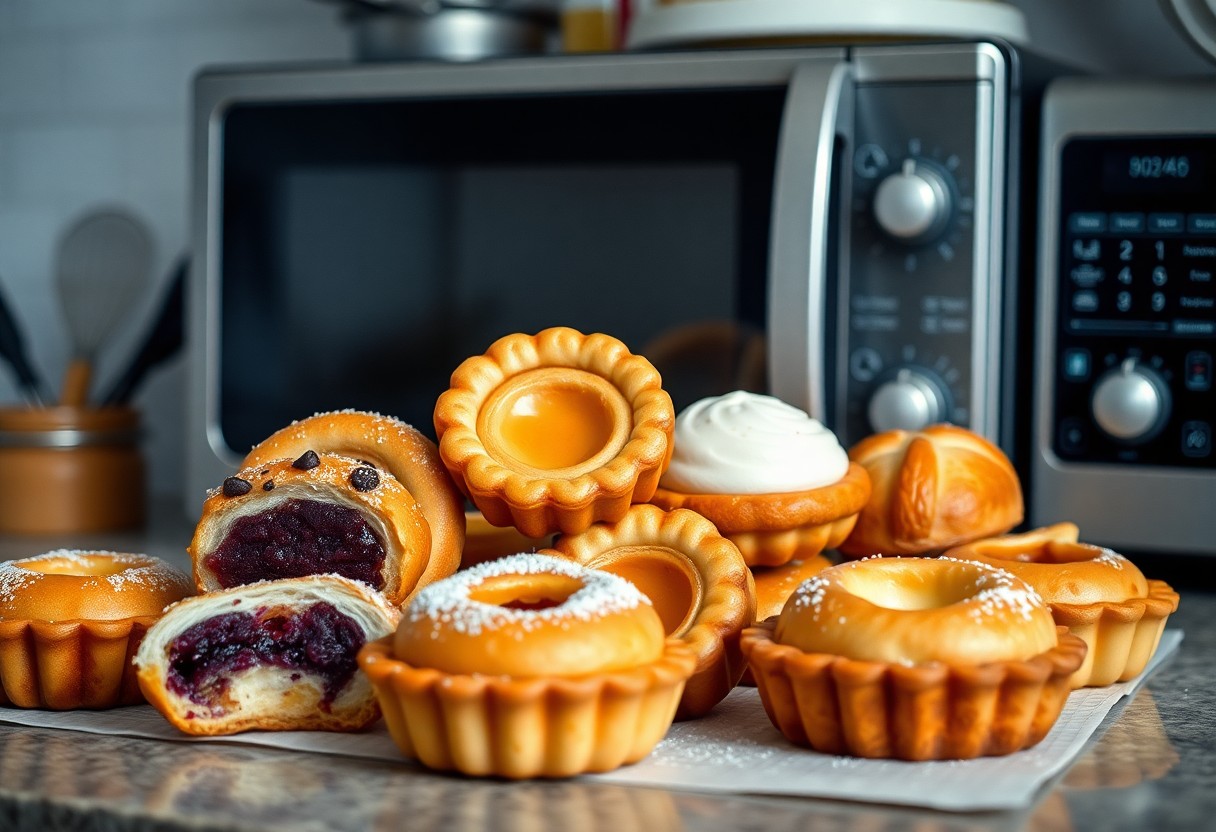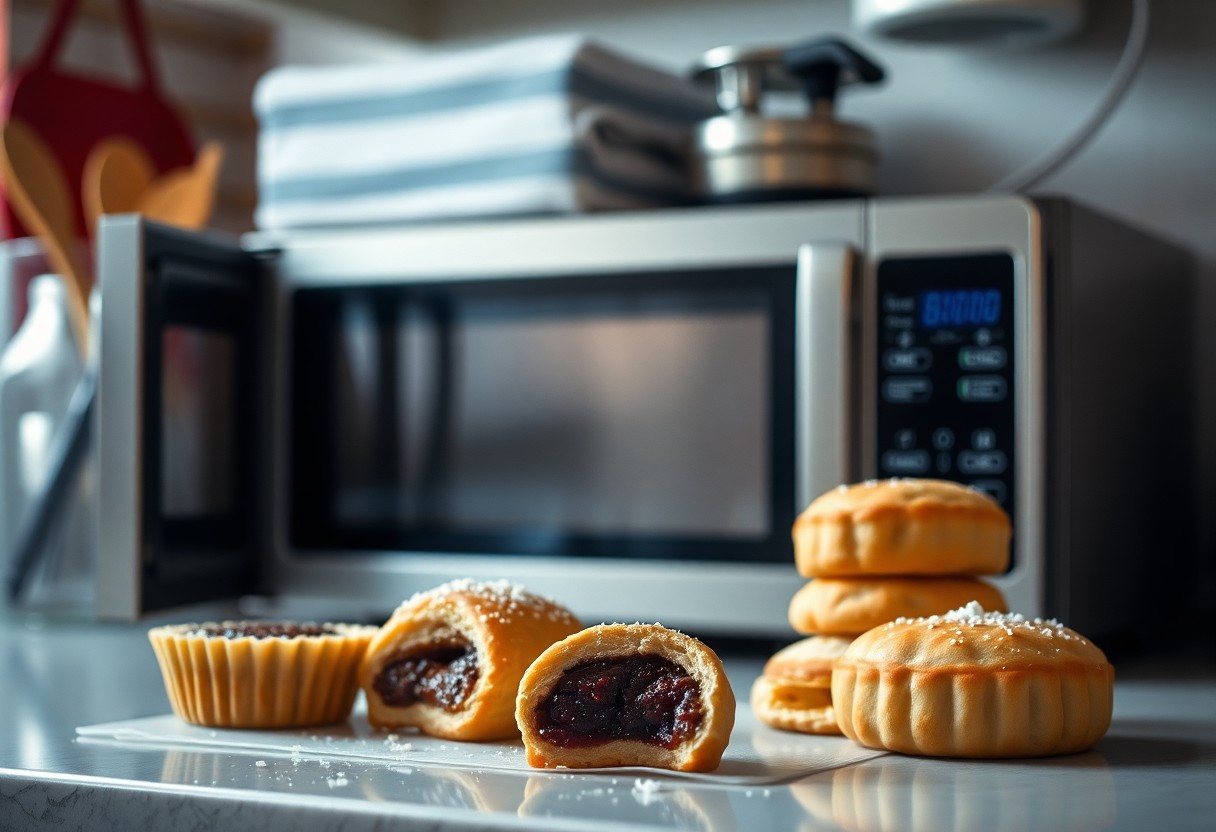With the rise of modern convenience in cooking, you might wonder if you can whip up delicious pastries using just your microwave. In this blog post, you’ll discover how to transform simple ingredients into delectable treats—all without the need for a traditional oven. But be mindful of the unique challenges and techniques involved to ensure your creations come out perfectly. Whether you’re short on time or space, let’s explore the world of microwave pastries together and see how you can revolutionize your baking experience!
Key Takeaways:
- Microwave pastries can be a quick and convenient alternative to traditional baking, allowing for effortless preparation in a fraction of the time.
- Textures and flavors may differ from oven-baked pastries, so adjustments in cooking times and techniques are important for achieving the best results.
- Experimenting with different recipes and ingredients can lead to innovative microwave pastry creations that still satisfy cravings for baked goods.
Understanding Microwave Cooking
The world of microwave cooking offers a convenient and efficient alternative to traditional baking. With the ability to cook food quickly, microwaves have transformed how we approach meal preparation. Understanding how they work and the differences compared to conventional ovens is vital for making the most out of your microwave, especially when it comes to baking pastries.
How Microwaves Work
Along with heating food by using electromagnetic waves, microwaves create heat through the rapid movement of water molecules within your ingredients. These waves penetrate food and cause these molecules to vibrate, generating heat that cooks your items from the inside out, making cooking faster than conventional methods.
Differences Between Microwave and Conventional Ovens
Microwaves can dramatically change your cooking experience. Unlike conventional ovens that rely on hot air circulation to cook food, microwaves utilize electromagnetic radiation to heat food quickly and evenly. This results in less moisture loss, allowing you to retain moisture in your pastries, but this method may not provide the same browning or crispiness that an oven achieves.
Another point to consider is that while microwaves cook food rapidly, they may not allow for the same level of browning and caramelization that conventional ovens achieve due to their cooking process. This can make a difference in texture and flavor in baked goods. Furthermore, using a microwave often results in uneven cooking unless you rotate your dishes. Keeping these factors in mind can help you adjust your microwave baking techniques to achieve the best results possible.
Types of Microwave Pastries
While exploring the world of microwave pastries, you’ll discover a variety of options that fit different taste preferences and occasions. Here’s a brief overview:
| Sweet Pastries | Indulge in treats like mug cakes and chocolate croissants. |
| Savory Pastries | Enjoy delicious options such as cheese turnovers and spinach puffs. |
| Fruit Pastries | Try out microwave tarts and stuffed puff pastries. |
| Crescent Rolls | Serve quick and flaky rolls with your favorite fillings. |
| Fried Pastries | Make quick desserts like microwave churros. |
Knowing the different types of pastries available allows you to choose based on your cravings, whether sweet or savory.
Sweet Pastries
For those with a sweet tooth, microwave pastries offer delightful options like mug cakes and chocolate-filled croissants. You can quickly whip up a rich dessert in just minutes, making it perfect for last-minute cravings or quick indulgences.
Savory Pastries
Pastries can also tantalize your taste buds with hearty fillings. Microwave options like cheese turnovers and spinach puffs are excellent for a quick snack or meal.
For instance, you can fill a pastry with cheddar cheese and herbs, then microwave it for a warm and flaky treat that’s perfect for lunch or a snack. These savory pastries are not only convenient but also allow you to experiment with flavors and fillings, making them a versatile choice for your microwave cooking adventures.

Essential Microwave Baking Tools
Now that you’ve decided to commence on your microwave baking journey, having the right tools will enhance your experience and streamline the process. Investing in the crucial microwave baking equipment not only ensures safety but also helps you achieve delicious results. From bakeware to measuring tools, these items will elevate your microwave pastry game and make it easier to whip up sweet treats in no time!
Microwave-Safe Bakeware
Between traditional bakeware and microwave-specific options, it’s vital to choose wisely. Look for containers labeled as microwave-safe, such as glass or silicone, to avoid the risk of melting or leaching harmful chemicals into your food. Always check for any markings or guidance from the manufacturer to ensure safety while using your microwave.
Measuring Tools
Microwave baking requires precision, and having accurate measuring tools is crucial for achieving the perfect texture and flavor. Invest in a good set of measuring cups and spoons, along with a kitchen scale for measuring ingredients by weight when necessary.
In fact, using measuring cups, spoons, and a kitchen scale can make a significant difference in your baking results. When you measure ingredients precisely, you reduce the risk of errors in your recipe that could lead to undesirable textures or flavors. For instance, using too much flour can result in dense pastries, while too little can leave you with a gooey mess. By utilizing these tools, you ensure that your ingredients are balanced, enhancing the quality of your microwave pastries.
Microwave Pastry Recipes
For those who want to enjoy the ease of making pastries without the hassle of an oven, microwave pastry recipes can be a fantastic solution. These recipes offer quick alternatives that allow you to create delightful treats in record time. Whether you’re craving muffins, cakes, or pie, you can explore various microwave techniques to satisfy your sweet tooth.
Quick Muffins
Against traditional baking, microwave muffins can be made in just a few minutes, providing a delightful breakfast or snack option. By mixing your ingredients in a microwave-safe mug or bowl, you can create a customized muffin to suit your tastes, resulting in moist and fluffy bites without the wait.
Chocolate Lava Cake
One of the most alluring desserts you can prepare in the microwave is the infamous chocolate lava cake. This treat features a gooey, molten center that oozes out with each bite, offering an indulgent experience.
For instance, by mixing together basic ingredients like butter, sugar, eggs, flour, and chocolate and microwaving them, you can achieve that desired lava-like flow in about one minute. Make sure to keep an eye on the time, as overcooking may lead to a less liquid center. Using quality chocolate will elevate your dessert, ensuring a rich flavor that will impress anyone. The instant gratification of a homemade chocolate lava cake right from your microwave can transform any regular day!

Tips for Successful Microwave Baking
Unlike traditional baking, microwave baking requires a bit of finesse to achieve the desired results. Here are some handy tips for success:
- Use microwave-safe dishes
- Adjust your cooking times accordingly
- Keep your ingredients fresh
- Experiment with power settings
- Don’t overcrowd the microwave
Thou will find that with practice, your microwave pastries will turn out better each time.
Adjusting Cooking Times
Cooking times in the microwave can vary significantly based on your appliance and the size of your pastries. Start by using the lower end of the suggested time and incrementally adjust in small increments, to prevent overcooking. A good rule of thumb is to check your dish every 30 seconds until you achieve the perfect finish.
Achieving the Right Texture
Achieving a delightful texture in microwave pastries may seem challenging, but it’s entirely possible. You want your pastry to be fluffy and moist yet firm enough to hold its shape. One way to enhance texture is by incorporating air into your batter through careful mixing and even using cooking spray to help prevent sticking.
Adjusting the cooking time and power level can significantly influence the texture of your pastries. Be cautious while making adjustments, as under-cooking can lead to a soggy finish while over-cooking may create a dry product. For the best results, consider adding moisture-rich ingredients such as yogurt or applesauce. Keep a close eye on them as they cook, and you’ll soon master the art of microwave baking!
Common Mistakes to Avoid
Keep your microwave baking experience enjoyable by avoiding common pitfalls. Understanding the limitations of your microwave and making the right choices will lead to better results. Pay attention to portion sizes, cooking times, and ingredient choices to ensure your pastries turn out delectable and not rubbery or undercooked.
Overcooking
The key to successful microwave pastries is to avoid overcooking them, which can lead to a dry and tough texture. Each microwave varies in power, so it’s important to monitor your pastries closely. Start with shorter cooking times and check for doneness frequently to achieve the perfect consistency.
Using Improper Ingredients
Ingredients play a significant role in the success of your microwave pastries.
Further, using improper ingredients, such as low-quality flour or expired baking powder, can result in a subpar end product. Opt for fresh and high-quality ingredients to ensure that your pastries rise properly and taste delicious. Additionally, be cautious with microwave-safe containers; some materials can leach chemicals when heated. Always choose microwave-safe options to keep your baked goods both safe and scrumptious.
Final Words
Drawing together the benefits of microwave pastries, you can indeed create delicious treats without the need for an oven. By utilizing microwave-safe recipes and understanding the principles of microwave cooking, you can achieve delightful pastries in a fraction of the time. This method allows you to explore your baking skills and satisfy your sweet cravings effortlessly. Embrace the convenience of microwave baking, and enjoy the endless possibilities it offers in your kitchen!
FAQ
Q: What types of pastries can be made in a microwave?
A: You can make a variety of pastries in a microwave, including mug cakes, quick breads, and smaller versions of traditional pastries like puff pastry and tarts. Typically, recipes designed specifically for microwave cooking will yield the best results, as they account for the unique cooking method and time constraints of a microwave.
Q: How does microwave baking differ from traditional oven baking?
A: Microwave baking uses electromagnetic waves to heat food quickly, causing moisture to evaporate and the food to cook from the inside out. In contrast, traditional oven baking relies on dry heat circulation, producing a more even cooking process and often resulting in a crispier texture and browning on the outside. Because of these differences, microwave pastries may have a softer texture compared to those baked in an oven.
Q: Are there any tips for making microwave pastries rise properly?
A: To help microwave pastries rise, ensure that you are using the right leavening agents, such as baking powder or baking soda. It’s also beneficial to let your batter rest for a few minutes before microwaving, as this can enhance the rise. Additionally, be careful not to overload your microwave with too much batter at once; this can prevent even cooking and sufficient rising.
Q: Can I replicate the flaky texture of oven-baked pastries in the microwave?
A: Replicating the flaky texture of oven-baked pastries in a microwave can be challenging, as microwaves tend to steam food rather than give it a crisp finish. However, you can use techniques such as layering dough and ensuring the use of butter or oil to create some flakiness. Some recipes specifically designed for the microwave might also suggest using a microwave-safe dish that allows for better heat distribution.
Q: What are the benefits of using a microwave for making pastries?
A: The microwave offers several advantages for pastry-making, including significantly reduced cooking time, ease of use, and minimal cleanup. It’s an excellent option for quick snacks or desserts without the need to preheat an oven. Additionally, microwaving pastries can save energy compared to using a full-sized oven, making it a more efficient choice for small batches.
